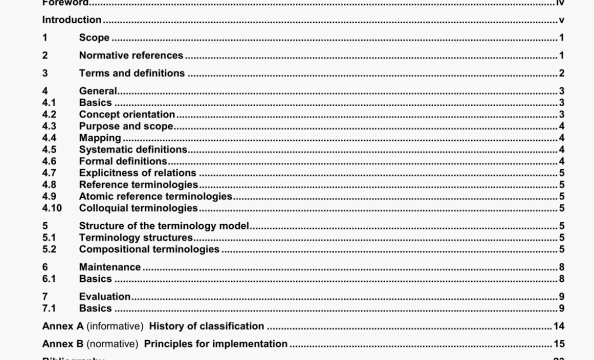ISO/TS 17117 pdf download – Health informatics – Controlled health terminology -Structure and high-level indicators.
4.3 Purpose and scope
Any controlled terminology shall have Its purpose and scope deafly stated In operational terms so that its fitness for particular purposes can be assessed and evaluated Where appropriate, it may be useful to illustrate the scope by examples or ine cases as in database models and other specification tools. Criteria, such as coverage and comprehensiveness, can only be judged relative to the intended use and scope.
EXAMPLE A terminology might be comprehensive and detaled enough for general practice with respect to cardiovascular signs, symptoms and disorders, but inadequate to a specialist cardiology or cardiotioracic surgery unit Conversely, a terminology sufficiently detailed to cope with cardiology and cardiothoracic surgery rnt be totaly impractical in general practice.
43.1 Coverage
Each segment of the healthcare process shall have explicit in•depth coverage, and not rely on broad leaf node categories that place specific clinical concepts together. The extent to which the depth of coverage is incomplete shall be explicitly specified for each domain (scope) and purpose as indicated in 4,3P1
EXAMPLE It is often important to distinguish specific diagnosis from categories presently labelled not elsewhere clessafied (NEC), or to differantieta disease seventy such as indolent prostate cancer from widely metaslatic disease.
4.3.2 Compr.henslv.ness
The extent to which the degree of comprehensiveness Is incomplete shall be explicitly specified for each domain (scope), and purpose as indicated in 4.3. Within the scope and purpose, all aspects of the healthcare process shall be addressed (or all related disciplines, such as physical findings, risk (actors, or functional status — across the breadth of medicine, surgery, nursing and dentistry. This criterion applies because decision support, risk adjustment. outcomes research and useful guidelines require more than diagnoses and procedures.
EXAMPLES The existing Agency for Healthcare Research and Quality Guidelines, and the Healthcare Finance Administration (14CM) mortality model.1t0)
4.4 Mapping
Government and payers mandate the form and classification schema for much clinical data exchange. Thus. comprehensive and detailed representations of patient data wdhin computer-based patient records should have the ability to be mapped to those classifications, such as ICD-9. This need for multiple granularities is required for clinical healthcare, as well as Is specified in ISOF1ECITR 9789. The degree to which the terminology is mappable to other classifications shell be explicitly stated.lttl
EXAMPLE An endocrinologist may specify more detM about a patient’s diabetes mellitus than a generalist working In a prwnary care setting, even though both speciateies may be canng for the same patient
4.5 SystematIc definitions
In order for users of the terminology to be certain that the meaning that they assign to concepts is identical to the meaning which the authors of the terminology have assigned to these definitions will need to be explicit and available to the users, Further, as relationships are built Into terminoloes, multiple authors will need these definitions to ensure consistency in authorship.
EXAMPLE The clinical concept Thypertension might be defined as a consistently elevated blood pressure and needs to be dislinguished frame single BP l485.
4.6 Formal definitions
A compositional system should contain formal definitions for non-atomic concepts and formal rules for ferring subsumption from the definitions, as specified in E-1 712.
5.2.1.2.1 Pre-coordlnated concpt
Such an entity can be broken into parts without loss of meanmg (can be meaningfully decomposed). when the atomic concepts are examined in aggregate. These are representations, wtuicti are considered single concepts within the host vocabulary. Ideally, these concepts should have their equivalent composite concepts explicitly defined within the terminology (that Is the terminology should be normalized for content, as Indicated in 5.2.2).
EXAMPLE The term colon cance? is non-atomic, however it has a single unique identifier, wtiich means to the SNOMED-RT that it represents a singl& concept It has the same status in the terminology as the site large bowe? and the diagnose neoplasm, maegnanr.
5,2.1.2.2 Post-coordinated concept
A post-coordinated concept is a composite concept which Is not pre-coordinated and therefore shall be represented as an expression of multiple concepts using the representation language. This is the attempt of a system to construd a set of concepts from within a controlled terminology to more completely represent a user’s query.
EXAMPLE The concept tacterlel effusion, left kneW Is not a ielque temi within the SNOMED-RT terminology. It represents a clinical concept that some patient has an Infected left knee joint As ii caviot be represented by a single concept identifier, to fully capture the intended meaning a system would need to build a representation from multiple concept identifiers.
ISO/TS 17117 pdf download – Health informatics – Controlled health terminology -Structure and high-level indicators
